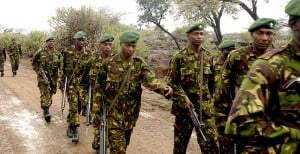 It’s been more than two weeks since Kenya sent its troops into Somalia. Initially, the incursion seemed like a short term retaliatory campaign in response to a series of kidnappings in northern Kenya. But, this past weekend, Kenya’s top commander said that troops will remain as long as necessary to vanquish the threat posed by al Shabaab.
It’s been more than two weeks since Kenya sent its troops into Somalia. Initially, the incursion seemed like a short term retaliatory campaign in response to a series of kidnappings in northern Kenya. But, this past weekend, Kenya’s top commander said that troops will remain as long as necessary to vanquish the threat posed by al Shabaab.
What does this mean? Nobody really knows for sure. Some speculate that Kenya is looking to establish a buffer zone to prevent cross border raids and kidnappings. Officials in Kenya say they do not plan to occupy southern Somalia like Ethiopia did from 2006 – 2009. Yet again, Kenyan officials have said their forces will not leave until the Shabaab has been eliminated, which could take years.
The incursion appears to be part of a coordinated strategy by governments in Kenya and Somalia to escalate pressure on the Shabaab. Both governments are urging the international community to get in the fight. On Monday, these two governments jointly appealed to the international community to impose a blockade on the port of Kismayo, an al Shabaab stronghold in the south. The port is a major source of income for the Shabaab, and proponents believe it would choke the group financially.
Will Kenya’s intervention be successful? It depends. Many believe it unlikely given previous failed attempts to stabilize Somalia and local animosity to foreign military powers. But, Kenya appears to have learned some lessons from the intervention in the 1990’s and Ethiopia’s more recent occupation. As noted, Kenyan officials have rejected an occupation of southern Somalia. Kenyan officials have also taken steps to mitigate civilian casualties, including using twitter to warn residents of attacks.
After initially opposing Kenya’s incursion, the Somali transitional government has reluctantly come on board. But, tepid support for the campaign could quickly dissipate if Kenya’s military operations produce high civilian casualties. Already, Kenya is facing scrutiny over allegations that its jets bombed a refugee camp, which reportedly killed half a dozen civilians, and injured another 45.
Another factor to consider is the preparedness of Kenya’s military for this mission. Kenya has not engaged in any significant foreign military engagements since the 1960’s. As a result, some call Kenya’s military a “career army,” suggesting that they aren’t up for a real fight. Kenya’s security forces also don’t have the best reputation; they are widely perceived as corrupt and abusive, not attractive characteristics for “winning hearts and minds.”
While the military is considered more professional than the police, Kenya’s military campaign near Mt. Elgon several years back demonstrates that serious problems exist with the military too. Any reports of atrocities in Somalia could turn into a propaganda victory for al Shabaab.
For its part, Al Shabaab has responded by vowing retaliatory attacks in Nairobi. Analysts believe Shabaab elements were behind the two grenade attacks in Nairobi last week. Shabaab commanders have also called on the Somali diaspora to launch attacks inside Kenya. While Kenyan security services are conducting operations to root out Shabaab elements in Nairobi, increased pressure on the Somali diaspora could ultimately strengthen al Shabaab. Indeed, blowback from the intervention could undermine rather than restore Kenya’s sense of security.
Will Kenya succeed or fail? Will the humanitarian situation deteriorate as a result of the Kenyan campaign? It is too early to tell. The conduct of Kenya’s forces as they approach Kismayo will be an important marker, demonstrating whether these units can fight like a professional military. I am skeptical. The absence of clear goals, the experience of Kenya’s military in the Mt. Elgon region, and the Shabaab’s demonstrated ability to use the presence of foreign militaries in Somalia to their advantage are reasons to doubt the efficacy of this campaign.
Image courtesy of the U.S. Department of Defense.